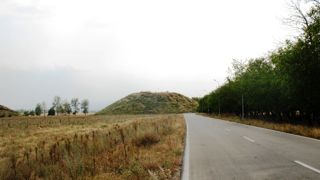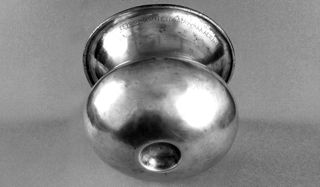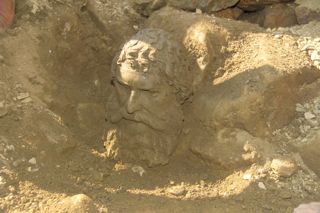Photos - personal archive of Diana Dimitrova and Ministry of Culture of Greece
In my personal opinion, based on the information that is available on the Internet, the facility in Amphipolis is not in a mound but in a natural hill. The terrain there consists of sandy rocks and it is easy to dig in it. I think the huge hill that we see is natural and the facility was excavated in it; it is not a mound piled up by human activity. This is my subjective opinion based on what I see in the media but  the colleagues will specify this more accurately. This is another difference from Golyamata Kosmatka that is a huge mound, the work of human activity. It is a huge hill, erected in the plain, at the foot of the mountain, but it was purposefully piled up and part of the embankment was removed afterwards, when the first part of the facility had to be built. We have documented this very clearly, based on the slope of the layers that fall to the facility itself. Therefore, I think this is one difference, but we will have more information once the excavations are completed.
the colleagues will specify this more accurately. This is another difference from Golyamata Kosmatka that is a huge mound, the work of human activity. It is a huge hill, erected in the plain, at the foot of the mountain, but it was purposefully piled up and part of the embankment was removed afterwards, when the first part of the facility had to be built. We have documented this very clearly, based on the slope of the layers that fall to the facility itself. Therefore, I think this is one difference, but we will have more information once the excavations are completed.
- Could you remind us of the tomb of Seuthes III, its architecture, size, the artefacts found in it?
- It is my pleasure to recall, 10 years after its discovery, the colossal event that has not yet been surpassed and I do not know if this will ever happen in the Thracian and Bulgarian lands in the coming years. The mound itself is very large. It is one of the most prominent in the Valley of the Thracian Kings, in particular at the foot of Stara Planina at Shipka, between Shipka and Kazanluk. A unique facility under the mound was found in it in 2004 consisting of an alley, facade before a 13-metre long corridor, three chambers, the latter being cut in the form of sarcophagus from a single stone block that probably weighs about 60 tons. This chamber has a cover that also weighs about 30 tons and resembles a gable roof. The facility was built in the early 4th century BC and the Thracian Odrysian aristocracy used it as a temple for a long time. Odrysian king Seuthes III was symbolically buried in it at the end of the 4th century BCand at the beginning of the 3rd century BC. Symbolically, because no bones were found in the third sarcophagus chamber. However, there were burial gifts and his name was inscribed on three of them. The name ‘Seuthes’ was written in genitive on the bronze helmet, on the metope, which means that it was his personal property. It was used by the king himself and when they had to perform this symbolic burial, it was in the capital city of Seuthopolis, which is why they put the used helmet there, not because they were not able to put a parade helmet.
 The name of Seuthes was also written on a silver phial, kylix type, and its weight was indicated in Alexander the Great tetradrachms. The same was written on the handle of a silver jug - the name of Seuthes and its weight in Alexander the Great silver tetradrachms. The wreath of the Thracian king, which was previously rumpled, was put on the bed, its leaves being scattered not only all over the third chamber. We found fragments of leaves in amphorae, we found a whole leaf and fragments of two other leaves carefully arranged between two rough stones built in the wall of the corridor.
The name of Seuthes was also written on a silver phial, kylix type, and its weight was indicated in Alexander the Great tetradrachms. The same was written on the handle of a silver jug - the name of Seuthes and its weight in Alexander the Great silver tetradrachms. The wreath of the Thracian king, which was previously rumpled, was put on the bed, its leaves being scattered not only all over the third chamber. We found fragments of leaves in amphorae, we found a whole leaf and fragments of two other leaves carefully arranged between two rough stones built in the wall of the corridor.

This means that the wreath, at least at the time of the construction of the facade and the south end of the corridor, had already been put inside the chamber. We are still exploring and asking, and trying to answer, the question as to what was the sequence of construction of the facility, its use, and the extension of the corridor. Obviously, at first the structure consisted of only that part of the unit, which was built of finely cut stone blocks, namely of the three chambers - rectangular, round and sarcophagus, and a very well constructed facade without decoration. This was the entire facility.
The corridor was built afterwards, it is possible that its south end and the facade be built after the  rituals themselves and the placement of the burial gifts inside the third chamber. However, it happened shortly after putting the gifts and the wreath inside. Once all these rituals had been performed, a bronze head from a statue of the Thracian king himself was placed at a distance of 7 metres in front of the facade, on the alley that was carefully separated with pebbles. We think this is a portrait of the Thracian king Seuthes III, which we established based on images on his coins. The profile of the head and the profiles on the coins are very much identical and similar. Probably the statue was placed somewhere in the capital city of Seuthopolis and it is a unique work of ancient art. It was probably made between 325-320 BC by Greek sculptor Silanion. This is the hypothesis of an Italian art expert, Paolo Moreno, and other researchers, including its discoverer Georgi Kitov, agree with it too. Probably it was made by him or it was made in is his studio. This is indicative of the extraordinary economic power of Thracian king Seuthes III and of his prestige, because he was able to order such an expensive work of art.
rituals themselves and the placement of the burial gifts inside the third chamber. However, it happened shortly after putting the gifts and the wreath inside. Once all these rituals had been performed, a bronze head from a statue of the Thracian king himself was placed at a distance of 7 metres in front of the facade, on the alley that was carefully separated with pebbles. We think this is a portrait of the Thracian king Seuthes III, which we established based on images on his coins. The profile of the head and the profiles on the coins are very much identical and similar. Probably the statue was placed somewhere in the capital city of Seuthopolis and it is a unique work of ancient art. It was probably made between 325-320 BC by Greek sculptor Silanion. This is the hypothesis of an Italian art expert, Paolo Moreno, and other researchers, including its discoverer Georgi Kitov, agree with it too. Probably it was made by him or it was made in is his studio. This is indicative of the extraordinary economic power of Thracian king Seuthes III and of his prestige, because he was able to order such an expensive work of art.